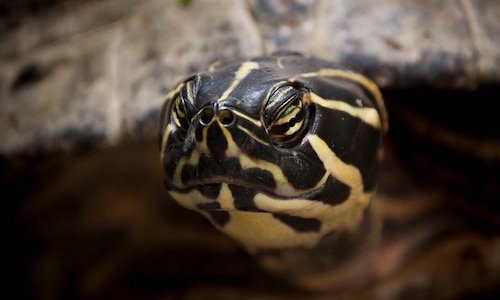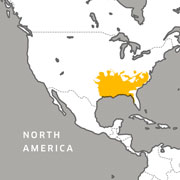Appearance:
River cooters are large, olive-colored aquatic turtles. Cooters have distinct yellow stripes that run down the head and neck. Their carapace (top part of shell) is typically dark greenish- brown and not highly domed. The plastron (bottom part of shell) is yellow to reddish-orange with darker markings between the scutes (shell plates). Males have larger claws than females so they can grasp females during mating.
Size:
Shell length: 12 – 16 inches. Females are slightly larger than males.
Diet:
Primarily herbivorous, eating water plants, algae, pondweeds, fallen leaves and seeds of trees. They will rarely eat crayfish, carrion, tadpoles, snails and insects.
Reproduction:
Breeding season is in early spring. The male uses his long claws to flutter at the face of a female. If the female is receptive, she will sink to the bottom of the river, allowing the male to mate with her.
Incubation:
Nesting occurs in late May or June. Female cooters will deposit their eggs in sandy soil within 30 yards of the water. She typically lays 12-20 eggs and then abandons the nest. The eggs hatch 90-100 days after being laid.
Behavior:
Common cooters prefer to remain in the water. They only come to land to bask and lay their eggs. At the first sign of danger, they slip back into the water.
Role in their habitat:
Most of the predators that prey on common cooters can only do so when turtles are young. Common cooters are known as a biological control for invasive water plant species such as the water hyacinth due to the turtle's preference for plant matter.
Habitat/range:
Cooters prefer slow to moderate moving rivers and streams throughout the Southern United States. Some may be found in lakes or in brackish water (water that has more salinity than fresh water, but not as much as sea water).
Median Life Expectancy:
35 years
Fun Facts:
- A distinctive feature of cooters is that they have cloaca bursae. These are a pair of internal pouch-like structures that allow for greater gas exchange. This makes it easier for them to absorb oxygen and stay underwater for longer periods of time.
- They've been known to walk long distances over land to reach new water sources.
- Like most other freshwater turtles, they have a sleek but protective shell. This allows them to withdraw when threatened, but still efficiently reduce water drag.





